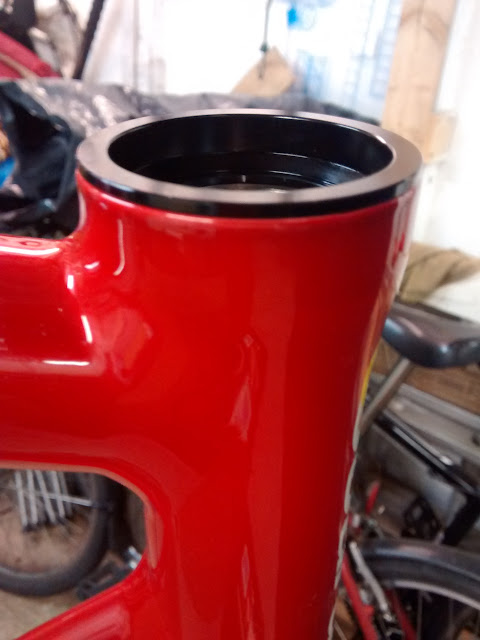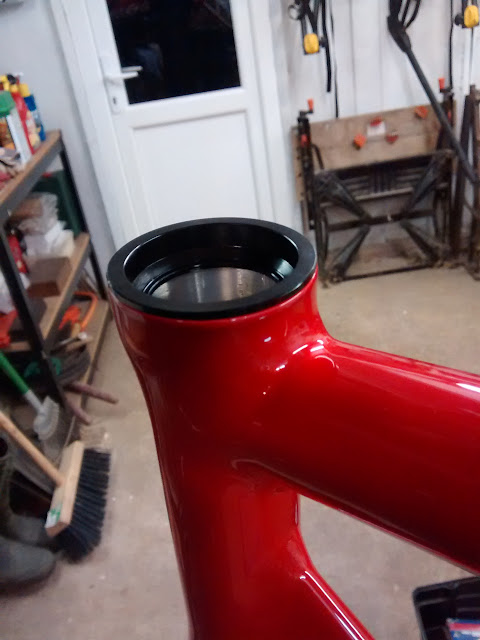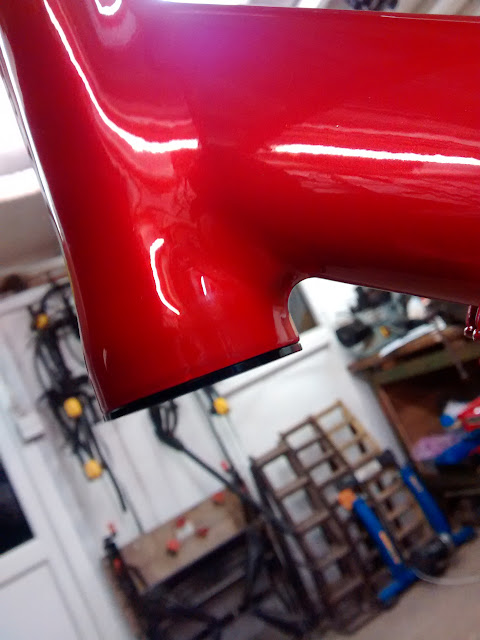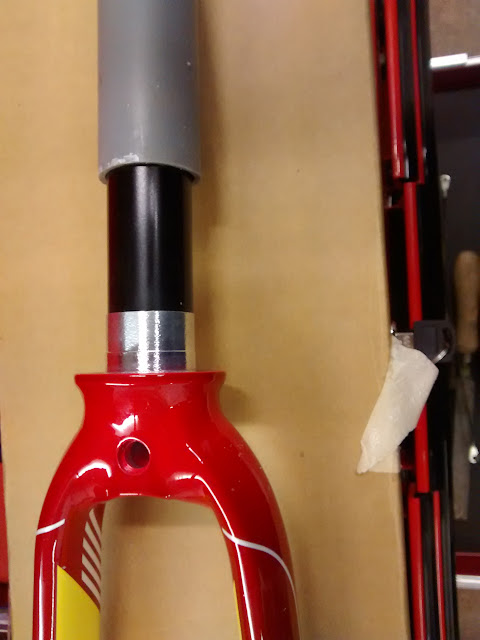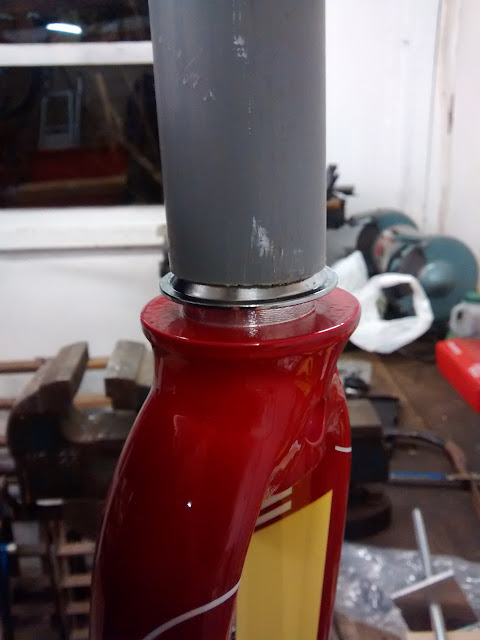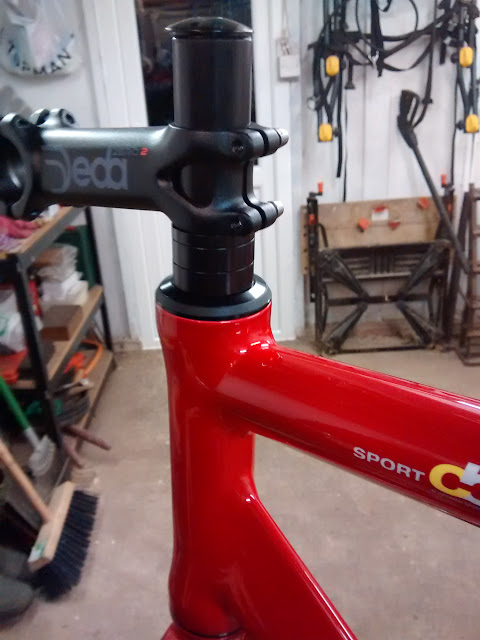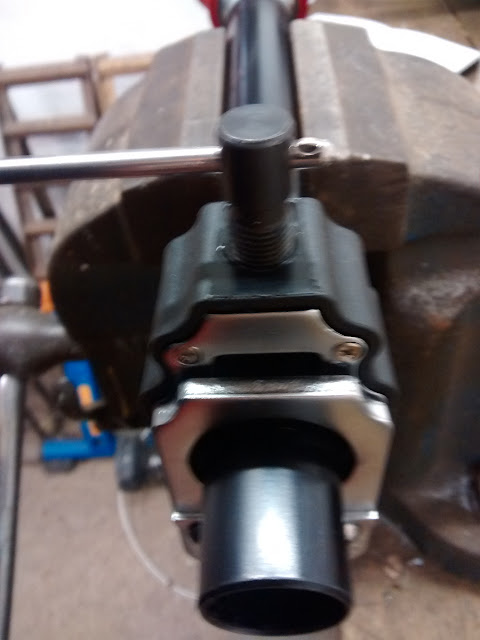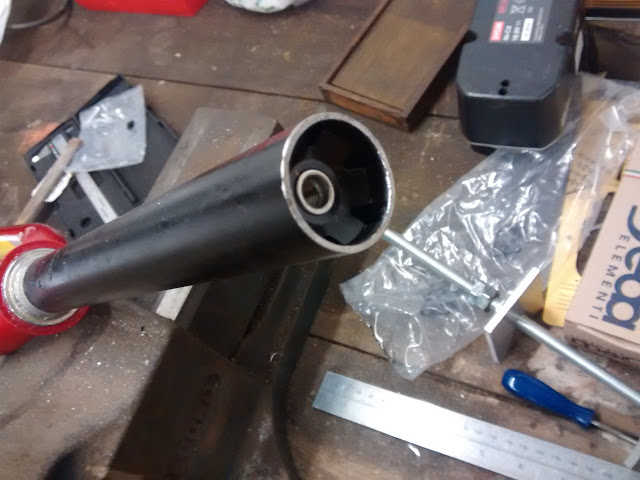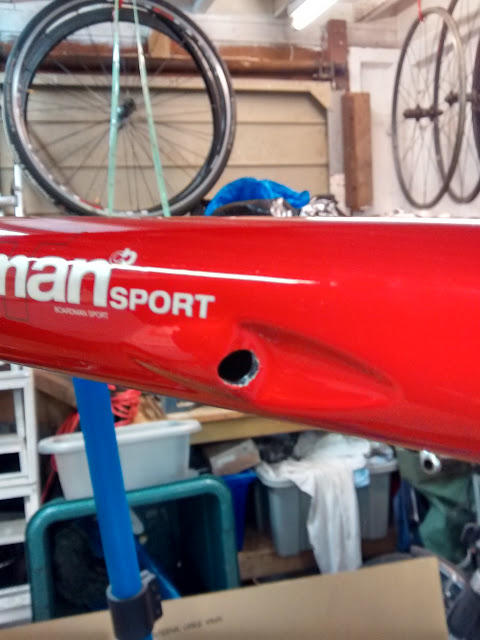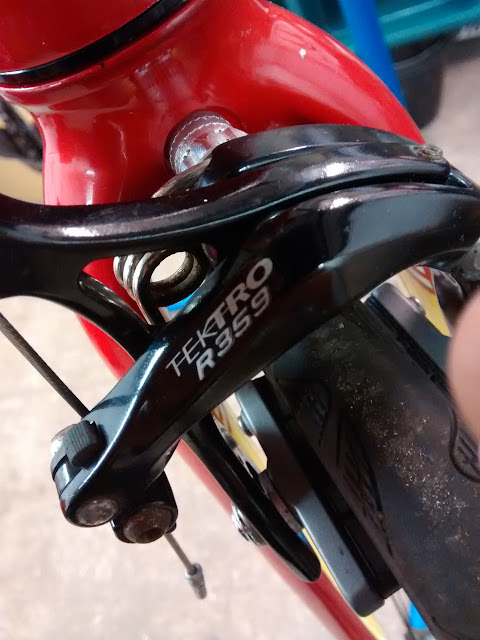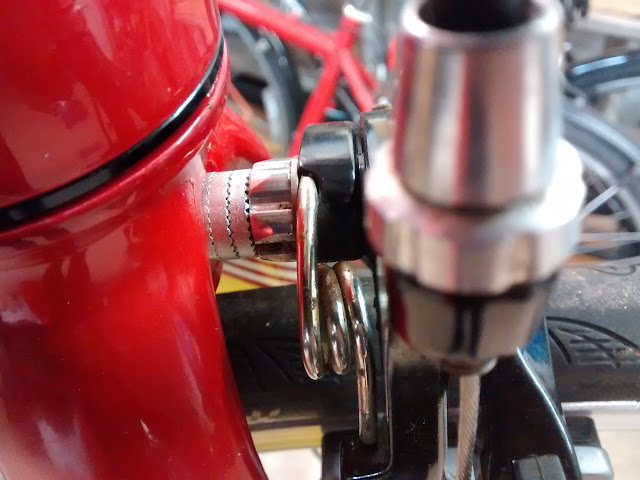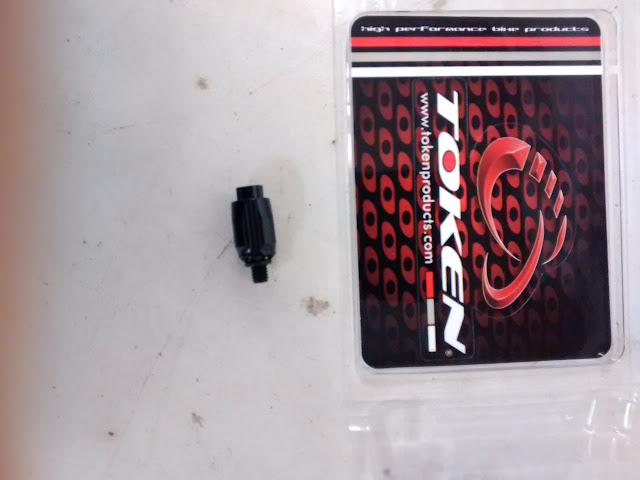I am a very happy Pro subscriber to Veloviewer
Here's a great graphical Summary:
Spot the holiday in France on the elevation graphic at the bottom!
Wednesday 23 December 2015
Tuesday 15 December 2015
More component weights
I "upgraded" my Scott with a full Shimano 5800 11 speed groupset recently. As I had most of the bike in bits I took the opportunity to weigh some parts again and collate the results here. I also reverted my Giant back to "full winter mode" and weighed some of the parts again, so this table is a bit of a mismatch of data
Component
|
Weight
|
Comment
|
(kg)
|
||
FSA Saddle
|
0.32
|
Original saddle from my Focus
|
Selle Royal saddle
|
0.29
|
Ties up with comments from other people who have
bought this saddle (Offer from Edinburgh Cycle Collective at £10)
|
105 5700 Front Derailleur
|
0.07
|
Weighed Before
|
105 5700 Rear Derailleur
|
0.23
|
Weighed Before
|
FSA Vero LH Crank (Non Drive Side)
|
0.23
|
Square Taper |
FSA Vero RH Crank Compact (Drive Side)
|
0.44
|
Square Taper |
Shimano 105 5700 Crank (Non Drive Side)
|
0.19
|
Lighter than the FSA Vero which I think would be
expected!!
|
Shimano 105 5700 Compact Crank (Drive Side)
|
0.54
|
Heavier than the FSA Vero!! Although does include
the centre shaft which the Vero (square taper) does not need. Whether that’s
100g I am not sure
|
Shimano 105 5800 Compact Crank (Drive Side)
|
0.55
|
Heavier in weight compared to the previous model
(within capability of my scales)
|
Shimano SPD MTB pedals
|
0.4
|
|
Stock Giant Front wheel/Continental GatorSkin tyre/tube/skewer
|
1.94
|
|
Stock Giant rear wheel/ Continental GatorSkin tyre/tube/skewer/Tiagra
cassette 28-12
|
2.09
|
This felt heavier than this so I don't believe my scales although I got 3 repeat readings at this weight |
Shimano Ultegra Front Wheel/ Continental GP
4000SII tyre/tube/skewer
|
1.10
|
Much lighter than the entry level Giant wheel as I'd hope
|
Shimano Ultegra Rear Wheel/ Continental GP
4000SII tyre/tube/skewer Ultegra 12-30 Cassette
|
1.80
|
Whilst lighter than the entry level Giant wheel
not to the same extent as the front wheels
|
Shimano Ultegra Skewer
|
0.06
|
Borderline if my scales can measure this reliably
|
Shimano Ultegra Rear Wheel/ Continental GP
4000SII tyre/tube/skewer (no cassette)
|
1.30
|
I don’t believe that an Ultegra 12-30 cassette
weighs 500g
|
Rear Brake (Tektro)
|
0.13
|
|
Front Brake (Tektro)
|
0.13
|
|
Front Brake Shimano 105 5700
|
0.18
|
How can this be heavier than the Tektro?
|
Rear Brake Shimano 105 5700
|
0.18
|
How can this be heavier than the Tektro?
|
Shimano 105 5700 Shifter
|
0.22
|
Left and Right weigh the same |
Saturday 5 December 2015
Building Yet Another Bike
(Updated 22 Dec 2015)
At the start of November 2015 I was knocked off my bike. As a result my Giant Defy was written off. Coincidentally I had been half looking for a cheap frame and fork to buy to put all my spare components onto and build a 3rd bike. I had been looking on and off for several months but by luck saw a brand new Boardman Road Sport Frame & Forks (55cm) on Ebay at an acceptable price:
I put a bid on and didn't expect to win but to my surprise I was the only bidder and won. Not only that, having paid, I found out that the seller worked a couple of miles from my house so although I waited a few days longer got it delivered for free.
The next step was to get hold of the bits that I did not have. This was: headset, dérailleur cable guide under the bottom bracket, band on front dérailleur adaptor and brake cable end stops for the internal rear brake cable. I had a complete 105 5700 Group set, handle bars, stem, saddle, pedals, wheels and nearly everything else from a number of previous upgrade projects, so hoped that the whole build would come in at around £100.
It took some careful measuring and research but I was able to source all the parts, either from Wiggle, Evans Cycles or Ebay. The biggest consideration was whether or not to have the headset fitted or to do it myself. I have had it done before for several reasons - 1 - you need some special tools that I am unlikely to use that often and 2 - getting the right headset can be difficult.
However I decided that I'd do it myself and either buy or make the tools, not least because seller thoughtfully provided the specific details needed for the headset - that is as per the
SHIS number (Cane Creek - Standardised Headset Identification System) it was:
ZS 44 / 28.6 | ZS 44 / 30
To understand the SHIS numbers it is as follows: red text = headtube sizes Top | Bottom and text in green = fork steerer tube diameters Top | Bottom
Even with this information (and measuring the frame and forks with a digital vernier gauge) it was still quite hard to source and head set to this size at a reasonable price. In the end I found one on EBay, it was an "Oxford Components" brand.
The bearings themselves were (semi) sealed units and were ID = 30.2mm, OD = 41mm, Height =7.4mm, contact angle 45Deg. The bearings were marked as "CBB41 4D16":
Its just about possible to see on this photo
The tools needed were a headset press, crown race press and steerer cutter. An internet search shows that a headset press and a crown race seating tool can be home made. Cutting the steerer tube is tricky and I decided to buy a saw guide - I got the Topeak Threadless Saw Guide Tool from Evans Cycles at just under £20.
The Headset press I made with some 10mm studded rod and some aluminium plate that I had from a previous project. I cut 2 pieces of the plate into a square bigger than the 44mm diameter of the bearings and drilled a hole through the centre. Here it is before I pressed the bearing races in:
It worked quite well but the plate tended to slip to one side a little so it was necessary to tighten a little at a time and ensure that the bearings were being pulled in square and then loosening and re-aligning slightly to pull down another little turn. Despite this the bearings were inserted square within less than 10 minutes. It would obviously have been quicker with a proper tool but this one cost me nothing.
Here are the races seated:
For the crown race seating tool a different approach was needed. Again an Internet search says to knock it down with a piece of plastic plumbing pipe. Luckily I had a piece of this as well:
I had a little more trouble here - I could only drive it on a little way and then at an angle. I measured again and the vernier suggested just a few 100ths of a mm difference in the inner diameter of the race and outer diameter of the fork as you'd expect but it just would not go on. Therefore I very carefully used a fine file and dressed the fork surface a little. After this the crown race could be driven on flush to the top of the fork crown.
I could then loosely assemble the fork and stem to mark up the steerer for cutting. I was fitting 25mm of spacers so I had a little scope for 1 mistake:
Having marked up I mounted the fork in the vice and fixed the tool onto the steerer and made the cut:
It was very easy and made a very straight cut:
I could then fit the star spangled nut.
There's probably a tool for this as well but I carefully put the bolt in the thread and pushed/tapped it in with a plastic mallet. Although it does need to be tight its only there for the pre-load setting so does not need to be a massive job. I was able to align it pretty well with some gentle tapping with a plastic mallet
With all these task complete I could then assemble the fork and headset properly and move on to the more routine tasks.
There were a couple of issues on the way. Both were related to the brakes.
The first was that the rear brake has an internal cable in the top tube. I had sourced these parts for the termination of the cable outers in to the frame from EBay:
Again some careful measuring of the frame and reference to the specification suggested that they should just drop in - they did not of course, but I was able to carefully open up the frame a little (it was probably a bit of paint and manufacturing tolerance) using the hand tool shown:
They fitted perfectly after this. I need to grease slightly this area to prevent the bare aluminium oxidising to quickly (which has happened to my son's bike).
The second problem was with both brakes. The Boardman frame needs longer drop brakes (57mm I believe) - the Shimano 5700 105 brakes I had were too short even with the pads at the lowest possible position. This was a bit of a blow but I had a spare set of Tektro brakes that had been fitted to my son's Boardman and these fitted. In addition, not just a longer reach is needed but also for the front brake I needed to pack out the brake from the fork using some on the ridged aluminium washers to stop the pads hitting the frame:
Thanks to Red Kite Cycles in Shirley for these in return for a biscuit fund donation.
Apart from this the build was reasonably straight forward.
I needed some threaded barrel adjusters for the front and rear dérailleur cables to join the down tube:
And then ended up with a completed bike:
I took a few weights:
Frame: 1.91 kg Fork: 0.91 kg
Final bike weight: 9.3kg which I thought was not too bad
The final specification is :
Frame: Aluminium 55cm "Boardman Road Race"
Fork: Aluminium Boardman
Wheels: Shimano RS80
Tyres: Continental GP4000S
Gears: Shimano 5700 105 10Speed
Chainset: Shimano 105 50/34 172.5mm
Rear Dérailleur: Shimano 5700 medium cage
Front Dérailleur: Shimano 5700
Cassette: Shimano 105 11-28
Chain: KMC 10speed with missing link
Pedals: Shimano R540
Brakes: Tektro
Stem: Deda
Handlebars: FSA Aluminium
Saddle: Selle Royale
Cost (excluding tools):
Frame: £75.55
Barrel Adjusters: £4.99
Cable Ends: £2.55
Headset: £21.99
Bar Tape: 12.99
Total: £118.07
Not bad for a reasonable specification bike
(Updated 22 Dec 2015)
The first ride was OK. I needed to drop the saddle ~5mm which I did mid-ride. The rear brake was also pretty poor. I made 2 modifications - firstly to shorten the outer cable where it entered the top tube and secondly to pack the pads from the arms.
The difference in the before-after states was only 5cm or so at most but has made a marked difference in feel and performance. I have looked at my son's Boardman (same frame) and in fact the cable is shorter still so there's possibly some room for further improvement.
The reason I packed the brake pads out (no photo available) is because the RS80 wheels fitted are quite narrow and this meant for the Tektro brakes they needed to be quite closed even in the normal position. This combined with the pads that are quite worn meant that I think quite a lot of the leverage is lost already even before the lever is pulled. There's probably only a few winter months left in the pads so I'll replace them and review the brakes then. If they are no better I'll probably get some of the long drop Shimano 57mm versions such as these:
At the start of November 2015 I was knocked off my bike. As a result my Giant Defy was written off. Coincidentally I had been half looking for a cheap frame and fork to buy to put all my spare components onto and build a 3rd bike. I had been looking on and off for several months but by luck saw a brand new Boardman Road Sport Frame & Forks (55cm) on Ebay at an acceptable price:
I put a bid on and didn't expect to win but to my surprise I was the only bidder and won. Not only that, having paid, I found out that the seller worked a couple of miles from my house so although I waited a few days longer got it delivered for free.
The next step was to get hold of the bits that I did not have. This was: headset, dérailleur cable guide under the bottom bracket, band on front dérailleur adaptor and brake cable end stops for the internal rear brake cable. I had a complete 105 5700 Group set, handle bars, stem, saddle, pedals, wheels and nearly everything else from a number of previous upgrade projects, so hoped that the whole build would come in at around £100.
It took some careful measuring and research but I was able to source all the parts, either from Wiggle, Evans Cycles or Ebay. The biggest consideration was whether or not to have the headset fitted or to do it myself. I have had it done before for several reasons - 1 - you need some special tools that I am unlikely to use that often and 2 - getting the right headset can be difficult.
However I decided that I'd do it myself and either buy or make the tools, not least because seller thoughtfully provided the specific details needed for the headset - that is as per the
SHIS number (Cane Creek - Standardised Headset Identification System) it was:
ZS 44 / 28.6 | ZS 44 / 30
To understand the SHIS numbers it is as follows: red text = headtube sizes Top | Bottom and text in green = fork steerer tube diameters Top | Bottom
Even with this information (and measuring the frame and forks with a digital vernier gauge) it was still quite hard to source and head set to this size at a reasonable price. In the end I found one on EBay, it was an "Oxford Components" brand.
The bearings themselves were (semi) sealed units and were ID = 30.2mm, OD = 41mm, Height =7.4mm, contact angle 45Deg. The bearings were marked as "CBB41 4D16":
Its just about possible to see on this photo
The tools needed were a headset press, crown race press and steerer cutter. An internet search shows that a headset press and a crown race seating tool can be home made. Cutting the steerer tube is tricky and I decided to buy a saw guide - I got the Topeak Threadless Saw Guide Tool from Evans Cycles at just under £20.
The Headset press I made with some 10mm studded rod and some aluminium plate that I had from a previous project. I cut 2 pieces of the plate into a square bigger than the 44mm diameter of the bearings and drilled a hole through the centre. Here it is before I pressed the bearing races in:
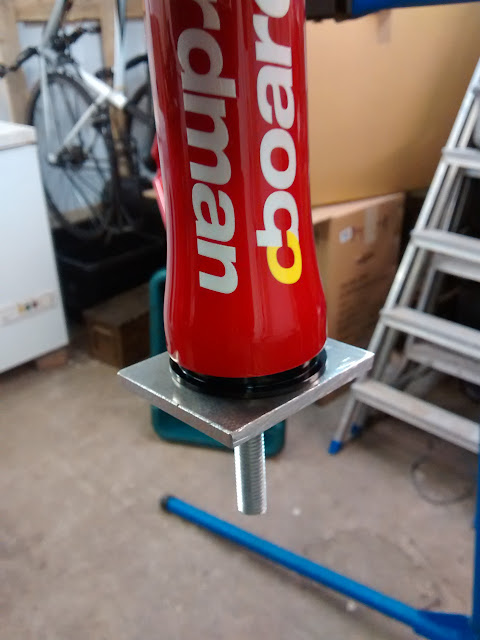 |
| Lower race before being fitted |
It worked quite well but the plate tended to slip to one side a little so it was necessary to tighten a little at a time and ensure that the bearings were being pulled in square and then loosening and re-aligning slightly to pull down another little turn. Despite this the bearings were inserted square within less than 10 minutes. It would obviously have been quicker with a proper tool but this one cost me nothing.
Here are the races seated:
I had a little more trouble here - I could only drive it on a little way and then at an angle. I measured again and the vernier suggested just a few 100ths of a mm difference in the inner diameter of the race and outer diameter of the fork as you'd expect but it just would not go on. Therefore I very carefully used a fine file and dressed the fork surface a little. After this the crown race could be driven on flush to the top of the fork crown.
I could then loosely assemble the fork and stem to mark up the steerer for cutting. I was fitting 25mm of spacers so I had a little scope for 1 mistake:
Having marked up I mounted the fork in the vice and fixed the tool onto the steerer and made the cut:
It was very easy and made a very straight cut:
 |
| The Steerer Tube Offcut |
There's probably a tool for this as well but I carefully put the bolt in the thread and pushed/tapped it in with a plastic mallet. Although it does need to be tight its only there for the pre-load setting so does not need to be a massive job. I was able to align it pretty well with some gentle tapping with a plastic mallet
With all these task complete I could then assemble the fork and headset properly and move on to the more routine tasks.
There were a couple of issues on the way. Both were related to the brakes.
The first was that the rear brake has an internal cable in the top tube. I had sourced these parts for the termination of the cable outers in to the frame from EBay:
Again some careful measuring of the frame and reference to the specification suggested that they should just drop in - they did not of course, but I was able to carefully open up the frame a little (it was probably a bit of paint and manufacturing tolerance) using the hand tool shown:
 |
| The hand tool used to open the holes |
The second problem was with both brakes. The Boardman frame needs longer drop brakes (57mm I believe) - the Shimano 5700 105 brakes I had were too short even with the pads at the lowest possible position. This was a bit of a blow but I had a spare set of Tektro brakes that had been fitted to my son's Boardman and these fitted. In addition, not just a longer reach is needed but also for the front brake I needed to pack out the brake from the fork using some on the ridged aluminium washers to stop the pads hitting the frame:
Thanks to Red Kite Cycles in Shirley for these in return for a biscuit fund donation.
Apart from this the build was reasonably straight forward.
I needed some threaded barrel adjusters for the front and rear dérailleur cables to join the down tube:
And then ended up with a completed bike:
I took a few weights:
Frame: 1.91 kg Fork: 0.91 kg
Final bike weight: 9.3kg which I thought was not too bad
The final specification is :
Frame: Aluminium 55cm "Boardman Road Race"
Fork: Aluminium Boardman
Wheels: Shimano RS80
Tyres: Continental GP4000S
Gears: Shimano 5700 105 10Speed
Chainset: Shimano 105 50/34 172.5mm
Rear Dérailleur: Shimano 5700 medium cage
Front Dérailleur: Shimano 5700
Cassette: Shimano 105 11-28
Chain: KMC 10speed with missing link
Pedals: Shimano R540
Brakes: Tektro
Stem: Deda
Handlebars: FSA Aluminium
Saddle: Selle Royale
Cost (excluding tools):
Frame: £75.55
Barrel Adjusters: £4.99
Cable Ends: £2.55
Headset: £21.99
Bar Tape: 12.99
Total: £118.07
Not bad for a reasonable specification bike
(Updated 22 Dec 2015)
The first ride was OK. I needed to drop the saddle ~5mm which I did mid-ride. The rear brake was also pretty poor. I made 2 modifications - firstly to shorten the outer cable where it entered the top tube and secondly to pack the pads from the arms.
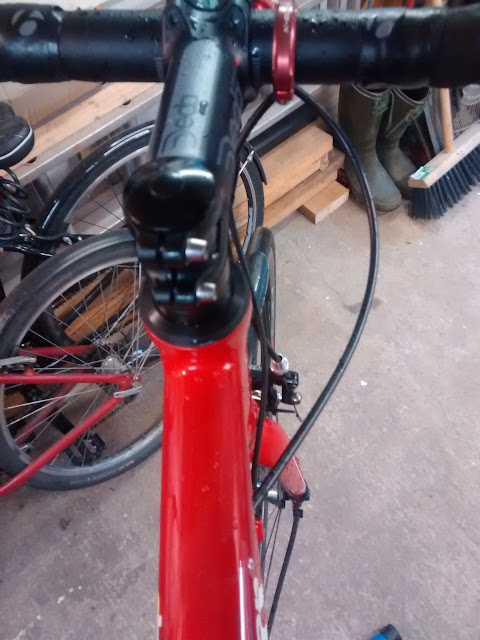 |
| Before |
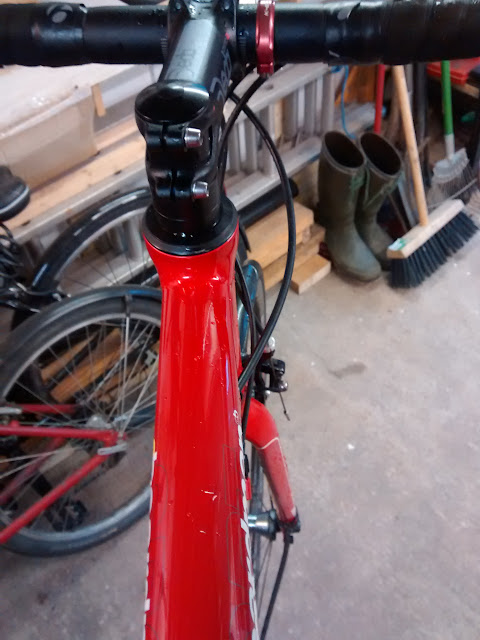 |
| After |
The reason I packed the brake pads out (no photo available) is because the RS80 wheels fitted are quite narrow and this meant for the Tektro brakes they needed to be quite closed even in the normal position. This combined with the pads that are quite worn meant that I think quite a lot of the leverage is lost already even before the lever is pulled. There's probably only a few winter months left in the pads so I'll replace them and review the brakes then. If they are no better I'll probably get some of the long drop Shimano 57mm versions such as these:
 |
| Shimano BR-R451 Dual Pivot 57mm Drop Brake Caliper |
 |
| Shimano R650 Dual Pivot 57mm Drop Brake Caliper |
Subscribe to:
Posts (Atom)




